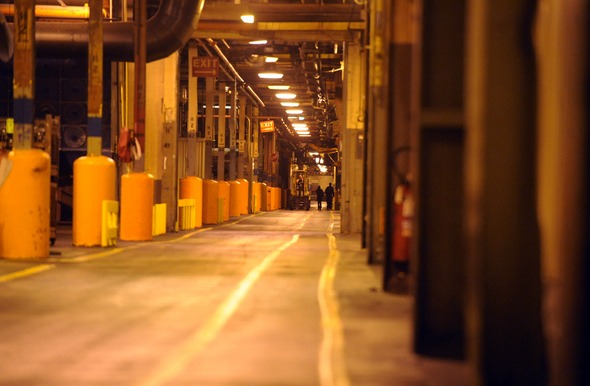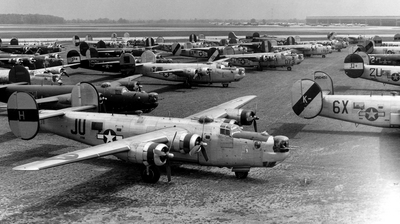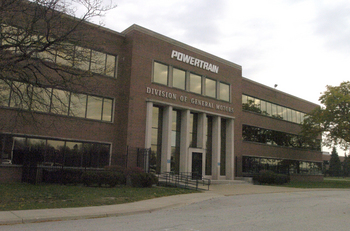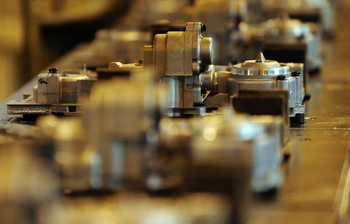'Most enormous room in the history of man': GM Willow Run plant history and facts

General Motors' Willow Run manufacturing plant is about 1.25 miles long.
Melanie Maxwell | AnnArbor.com
Here are some key facts and moments in the plant's history:
Henry Ford and World War II
--Henry Ford bought hundreds of acres of land at the site of the Willow Run creek and landed a contract from the federal government to construct a plant there to manufacture B-24 liberator bombers.
--Iconic architect Albert Kahn designed the complex, which he would later call “the most enormous room in the history of man, a single-story structure of a size never before conceived,” according to a GM-produced documentary.
--Construction started April 18, 1941, and the first parts were produced Dec. 8, a day after the Japanese attacked Pearl Harbor. The first complete bomber was finished Dec. 10, 1942.
--Massive hangar doors were included on the plant’s east side. They’re still there and they're operable.
--The floor slants downward ever so slightly from west to east, so that bombers could roll out of the plant, taxi onto the runway of the Willow Run Airport and fly off for tests. Parts of the floor were made of brick-sized wooden blocks that are still part of the foundation today.
--The plant was producing a bomber at a rate of one every 55 minutes. By the war’s end, the plant had made some 8,685 bombers. At one point, 42,000 people were working there -- including many women entering the industrial workforce for the first time -- and the plant was operating around the clock.
--Months after the war’s conclusion, the plant was sold to a company called Kaiser-Fraser, which made cars, military aircraft and equipment there until the plant was briefly closed in 1953.

B-24 Liberators, manufactured in at the Willow Run plant, await their shipment overseas at the next-door Willow Run Airport during World War II.
File photo
Plant transitions to GM
--After a fire destroyed GM’s Detroit Transmission plant in Livonia on Aug. 12, 1953, GM quickly struck a deal to buy the Willow Run site. In furious speed, 400 specialists moved the transmission operation to the Willow Run complex within 12 weeks.
--In 1963, the facility’s name was changed to GM Hydra-Matic.
--During the Vietnam War, workers made M16 rifles and aircraft cannons for the U.S. military.
--At one point in the 1970s, GM had some 14,000 workers working there. To handle massive demand for parking, workers were assigned to depart in six-minute increments.
--In 1980, Michigan Gov. William Milliken, saying the facility would “help meet the challenge of world automotive competitions,” dedicated it as a historic site.
--In 1991, the facility was renamed to reflect its status as a plant in the GM Powertrain Division.
--In 1993, after a protracted court battle, a next-door 2.5 million-square-foot GM assembly plant that employed thousands of workers was closed.

GM renamed the plant in 1991 when it became part of the consolidated Powertrain Division.
File photo | AnnArbor.com
--In 2002, GM announced that it would invest some $300 million to renovate about 1 million square feet of the plant, investing in a 6-speed transmission operation. By some accounts, GM ultimately spent more than double that. Today, that’s considered the most marketable part of the facility.
--On June 1, 2009, GM announced it would close the Willow Run facility by the end of 2010 as part of its bankruptcy restructuring. Nearly 1,400 workers were working there at the time.
--The plant produced more than 82 million automatic transmissions in its 57 years as part of GM.
--Today, the plant is about 5 million square feet and sits on 335 acres of property in Ypsilanti Township.
--The plant officially closes Thursday, Dec. 23, though half a dozen workers will stick around for a few months to attend to various tasks.
Future of the site

The GM plant manufactured transmission parts and complete transmissions.
Melanie Maxwell | AnnArbor.com
--The facility is now owned by Motors Liquidation Co., GM’s bankruptcy estate, which is contracting with consulting firm Alix Partners to marketing the site.
--Auctioneers have already conducted two auctions for equipment not being used at the plant. The rest of the equipment will be sold off in a few months. Historic items such as pictures and memorabilia will be preserved at a GM museum.
--Economic development officials and political leaders are marketing the site as part of the so-called “aerotropolis” plan for southeast Michigan, a proposal that would facilitate the attraction of shipping and logistics companies surrounding Willow Run and Detroit Metropolitan airports.
--Some $35.7 million is expected to be spent on environmental cleanup at the site as part of an environmental trust set up by the federal government and GM.
--GM paid some $5.4 million in property taxes for the site to Ypsilanti Township in 2009.
Sources: General Motors, Motors Liquidation Co., AnnArbor.com research and interviews.
Contact AnnArbor.com's Nathan Bomey at (734) 623-2587 or nathanbomey@annarbor.com. You can also follow him on Twitter or subscribe to AnnArbor.com's newsletters.


Comments
Spyker
Tue, Dec 21, 2010 : 12:05 p.m.
Facts and correction: 1) It is true that the east end of the plant is approximatley 5 feet lower than the west end, and this slope assisted with conveying the planes for the short distance after their wheels were installed, but the real reason for the sloping floor is that this is the natural slope of the land. In ~1940 it would have been exceedingly difficult to grade a site "dead flat" that was so large. 2) The oldest portion of the former GM Assembly plant was actually constructed by Ford at the same time as the Bomber Plant to serve as a parts warehouse for building the B24s. 3) A portion of the electricity consumed by the Bomber Plant was generated by the Ford Lake dam. Remnants of the underground electrical conduits linking the Ford Lake Dam to the Bomber Plant still exist today although much of conduits have been removed by subsequent I-94 freeway construction. 4) A small hydro-electric facility was constructed on the grounds of the Bomber Plant by damming Willow Creek. The dam still exists although it has been empty for years. 5) The entire perimeter of the Bomber plant was ringed by a small I-beam located above the plant's high windows for installation of "black-out curtains" to thwart night time bombing attacks by US enemies. 6) Most of the ~42,000 war time employees entered the plant via 10 to 12 elevated cross-overs that led from the north parking lots and south bus roadway to interior portions of the plant. Each exterior tower serving these elevated cross-overs contained a roof mounted anti-aircraft gun. Only one tower remains today. 7) The bomb sight was nearly the last component to be installed in the planes. Due to their highly technical nature, these bomb sights were stored in a multi-room vault guarded by fully armed US Army personnel.
Allen
Mon, Dec 20, 2010 : 7:13 p.m.
There's another fact to this site that no one talks about.....that land was an orchard and a vinigar plant that was owned by the Wiard family. They moved their farm to Merritt Rd. in 1940 and is still in business. The original farm was established in 1853 and was at the location until 1940 at which time a barn was moved, and is still in operation today, and trees were planted at the Merritt rd location. There are still alot of those trees still up and producing fruit. So many diffeent people were affected by the building of this plant in good and bad ways and it is very sad to know it will no longer employee people of it's community.
Basic Bob
Sun, Dec 19, 2010 : 11:41 p.m.
I think the Willow Run parking lot should be used as satellite parking for all foreign cars driven by public university employees and students.
YpsiLivin
Sun, Dec 19, 2010 : 7:54 p.m.
Clear it out, clean it up and use it as a replacement for Cobo Hall. You could easily put the entire Art Fair in there and get it off the streets of Ann Arbor.
Marvin Face
Sun, Dec 19, 2010 : 6:58 p.m.
You say the video was "produced"? I think not. I had motion sickness by about minute 1.
Hillbillydeluxe
Sun, Dec 19, 2010 : 12:34 p.m.
My Grandma worked at the Bomber plant then eventually ypsi ford plant. Very sad that the current six speed operation got moved out of a state. Also know a man who worked hard there for 30 years that provided him a good middle class lifestyle. Hopefully "Aerotropolis" might bring some middle class blue collar paying jobs to the region some day, I wish the employees well.
Dog Guy
Sun, Dec 19, 2010 : 12:28 p.m.
It's so close to two great public universities; it would make a fine imported car dealership.
jns131
Sun, Dec 19, 2010 : 11:39 a.m.
I still say an outlet mall would be a huge boon to this area. Fed Ex, UPS and all the other companies taking snippets of this huge building. Fly in fly out. What a concept.